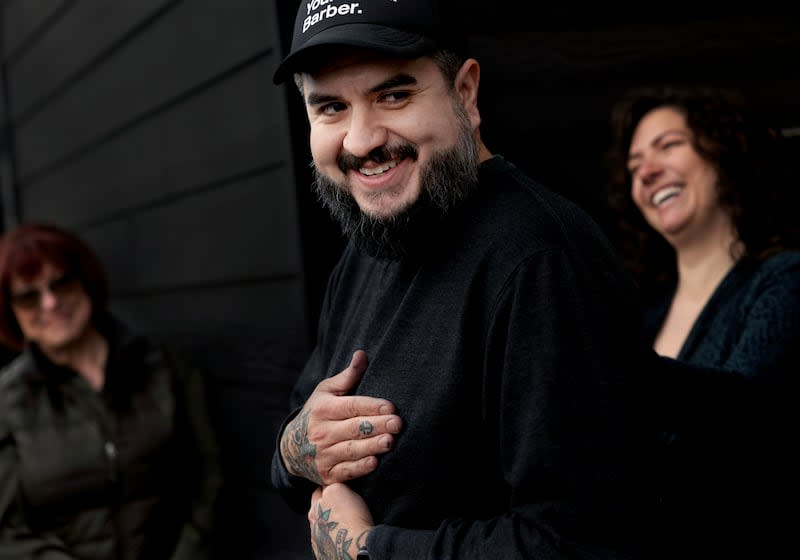West side story: Salt Lake City’s dramatic tale of change, challenge and a new horizon
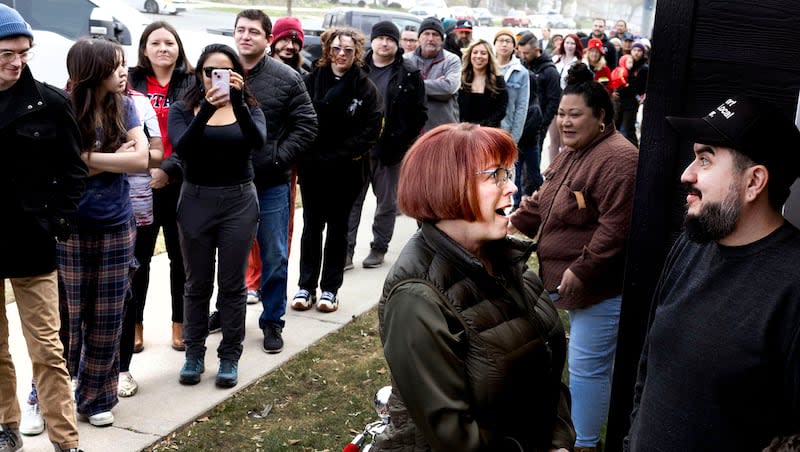
On a cold, blustery March morning with a big snowstorm looming, a line of people — Latino, Polynesian, Asian, Native American, Black, white — stretched around the block outside Culture Coffee in a west-side Salt Lake City neighborhood. Inside, the aroma of freshly brewed espresso from a machine designed like the back end of a lowrider filled the funky space with its exposed beams on the ceiling and ethnic artwork on the walls. Co-owner Isaac Atencio moved around the shop with nervous anticipation, chatting with baristas and making last-minute preparations for opening day.
Prior to inviting customers in, local politicians, the Pacific Islander Chamber of Commerce, and friends and family of Atencio and his business partner Eric Stone gathered outside in the wind for a ribbon-cutting ceremony.
“We don’t have this kind of stuff on this side of town, and we deserve it. ... It’s not just serving coffee to serve it. We’re trying to actually build community here and strengthen and empower,” Atencio said, his voice trailing off with emotion as the crowd clapped and cheered.
Atencio grew up on the west side. This is his neighborhood.
The building that houses Culture Coffee and connects to Atencio’s other business, Salt Lake Barber Co., which opened a year ago, sat vacant for a decade. The owner, NeighborWorks Salt Lake, a nonprofit focused on revitalizing neighborhoods, for years spurned substantially more lucrative offers from payday lenders and pawn shops as it waited for the right business to come along.
“In our case, we’re trying to amplify that message by showing that all you need is a catalyst for a few businesses to open in an area,” Atencio said. “Once you do and have that local representation, it makes the difference.”
During the past two months, we’ve walked west side neighborhoods and talked with those who live and work here. We’ve left most of the politicians out to take a look at what this often out-of-sight, out-of-mind part of Salt Lake City is all about. The “other side of town” or the “other side of the tracks” plays out in communities across America. Wealthier enclaves get the better homes, schools and stores, while the poor section gets hand-me-downs. But that’s about to change in the city.
Something big is brewing on Salt Lake City’s long-neglected west side, and it’s not just a new sit-down coffee shop. For perhaps the first time ever, powerful people in the state have taken an interest in breathing life into a section of town that has been gasping economically for decades.
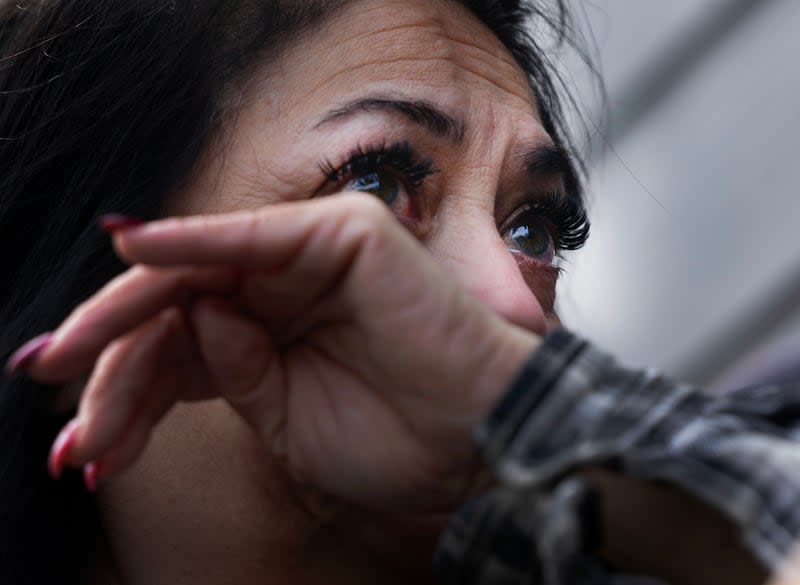
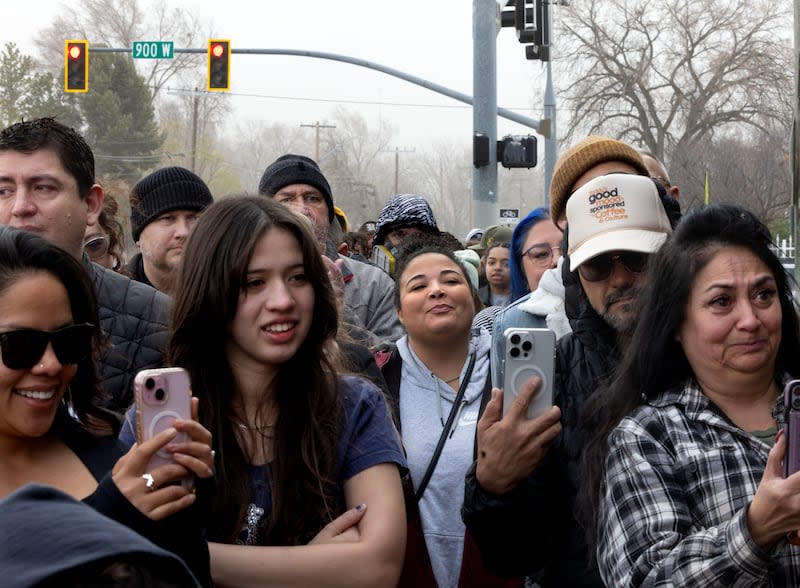
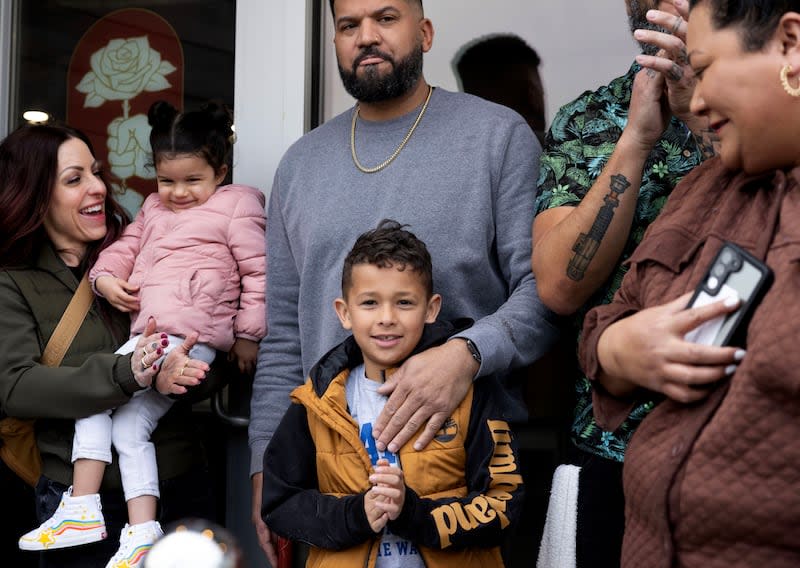
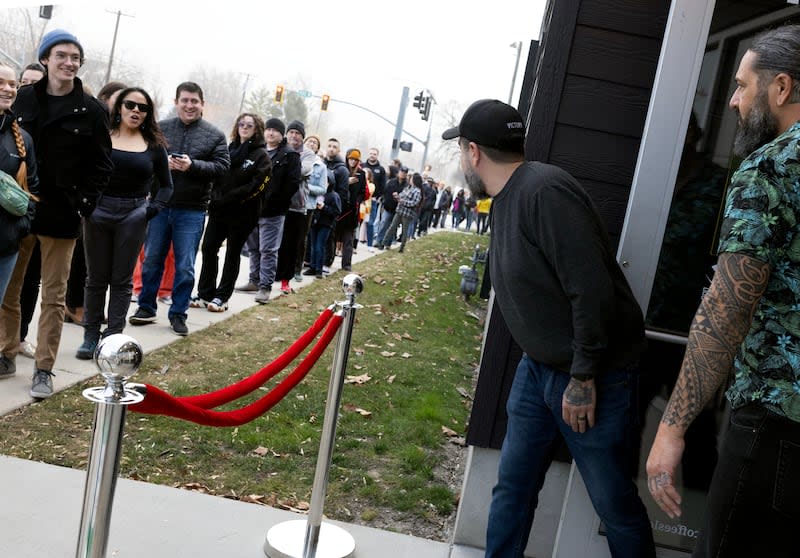
In January, the Larry H. Miller Company announced plans to put $3.5 billion into a mixed-use development, including a potential Major League Baseball stadium, a few blocks southwest of Atencio’s coffee shop. Utah lawmakers last month created a reinvestment and restoration district north of I-80 between 1000 West and Redwood Road that aims to clean up the trashy Jordan River that runs through the property and improve the Utah State Fairpark. The project is scheduled to begin in what’s known as the Power District in late 2024 with the construction of a new headquarters for Rocky Mountain Power.
Salt Lake City Council member Victoria Petro made sure west-side interests were represented at the Capitol during its 2024 legislative session.
“I just spent 45 days up on the hill, working where people have really big dreams for this area of the world, and every time they communicated those dreams, they started with words like blighted, depressed, needy. It made my skin crawl every time because that’s not who we are. This is who we are,” she told the crowd outside the coffee shop. “We are the west side. You are the west side. ... We’re not blighted. We just need a chance to rise.”
The west side, as it’s colloquially known, has endured a long history of political, racial and economic marginalization. Since the late 1800s, west-side residents worked in low-wage jobs and took the brunt of industrialization while being the last to receive public health and infrastructure upgrades. An EPA report last fall detailed disparities in air quality, health and socioeconomic outcomes in west-side neighborhoods, finding more negative effects from pollution than the rest of the city and, in some cases, the state.
Construction of the transcontinental railroad in the 1870s cut off Salt Lake City’s west side from the rest of the city, both racially and economically. Redlining — the discriminatory practice of denying not just individuals but entire neighborhoods access to mortgages — further isolated the area. Interstate 15 later cemented the cultural division between the whiter, wealthier east side and the less white, poorer west side. The median household income is under $57,000, compared to $63,000 for the city as a whole, and half of what it is on the east bench, according to the Kem C. Gardner Policy Institute.
Residents now worry planned I-15 expansion could take out homes bordering the freeway.
Other than a light-rail line to the airport, little to nothing has been done to improve the North Temple corridor, seen as the gateway to Salt Lake City. Save several new apartment buildings, the lack of investment in the area continues today.
“There’s been a lot of commitments and promises that have been made to this community that have been broken over decades,” said Maria Garciaz, CEO of NeighborWorks Salt Lake.
Despite the disadvantages, west siders take pride in where they live.
Several neighborhoods — Rose Park, Glendale, Westpointe, Poplar Grove, Fairpark, Jordan Meadows and People’s Freeway — comprise Salt Lake City’s west side, totaling about 70,000 residents. Some have their own community council. Small, typically well-kept post-World War II homes make up many of the neighborhoods. Community gardens, some with brightly colored murals of community advocates like Garciaz and Margarita Satini, who died of COVID-19 in 2020, and parks with youth league baseball fields are scattered throughout the community.
In some ways, it still appears like a scene out of “The Sandlot,” the iconic coming-of-age-baseball movie filmed partially in Rose Park. Children play in the street and run at the sound of the ice cream truck. Do-it-yourself projects are common in driveways. There’s a vibrant arts and culture scene and some of the best food in the city. It’s a place where a guy in a suit who works in a bank and a man who works outside with his hands attend the same school event or stand in line together at a food truck.
“I think that’s really beautiful. It’s fun to be around,” said Dan Strong, a Rose Park resident since 2012 and chair of the Westside Coalition, which works with the community councils to influence issues affecting residents.
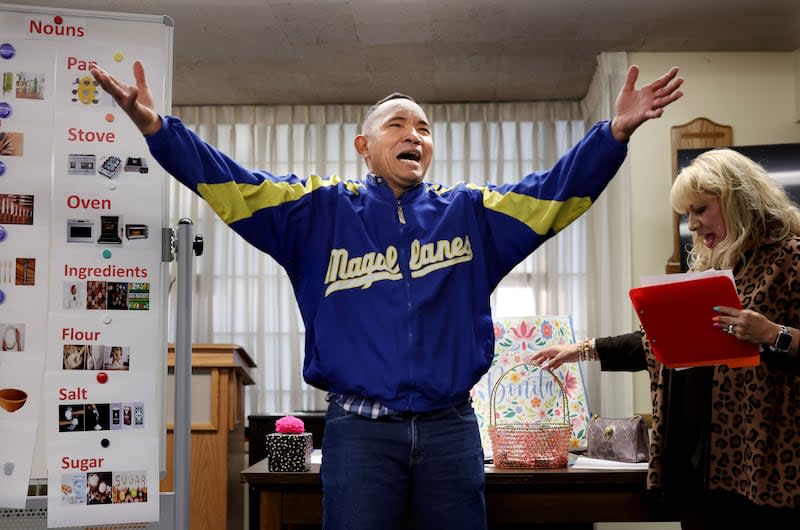
‘Kingdom of God’
Christian and Caitlin Bortz and their two young children were among those who waited in line at Culture Coffee on the first day. He doesn’t drink coffee but she does. They bought a house just down the street from the shop.
“We love the diversity,” Christian Bortz said.
The couple left their home in Tennessee where “everyone was white, everyone was wealthy” five years ago, he said. “We felt really comfortable there and we just didn’t like that comfort.” He explained that he and his wife are Christians and felt called to a place that challenges them and gives them opportunities to preach the gospel in their neighborhood.
“We’re not frequently around people from the islands or African Americans so we want to be in a place that’s actually diverse, that looks like the kingdom of God,” said Christian Bortz, who owns Seven Swans Home Services.
A large majority of west side Salt Lake City residents are people of color, with Hispanic/Latino representing the largest group at 48%. Half of the city’s foreign-born residents are west of I-15, home to 30% of the overall city population. Almost a third of west-siders are foreign-born, nearly double anywhere else in the city.
Life expectancy on the west side is about a decade less than it is on the east bench. Nowhere are there more households of four or more people. Neighborhoods have been facing gentrification, with new apartment buildings popping up and rental and housing prices skyrocketing. Save a few like the popular Red Iguana and Rancho Market, restaurants and other businesses along North Temple have a tough go.
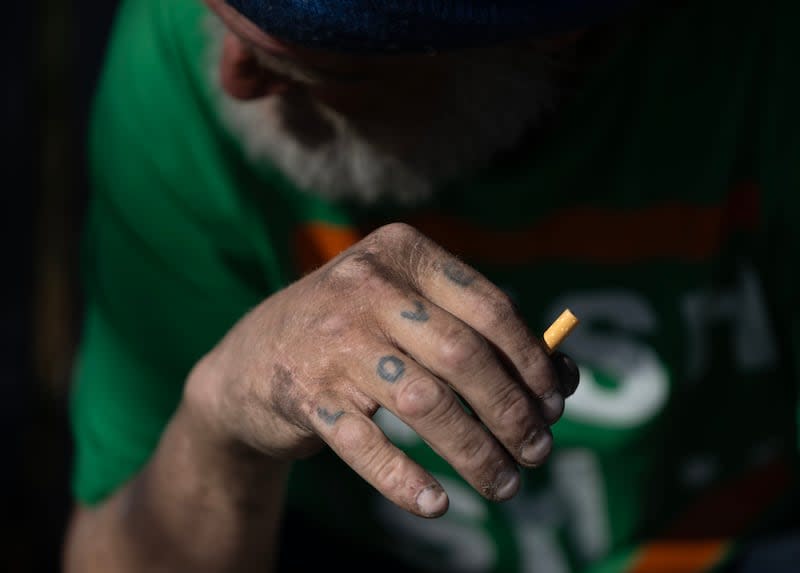
Crime and punishment
Homelessness has swelled in the Fairpark area. Drug dealing is rampant and in the open.
Encampments of unsheltered people come and go along the Jordan River between I-80 and 1000 North. Salt Lake City’s Rapid Intervention Team along with police routinely dismantle campsites only to have people return a few hours later. But homelessness is not the biggest problem. Organized crime is intermingled with the camps, bringing people into the neighborhood to buy drugs or solicit prostitution. Drug lords enlist unsheltered people and undocumented immigrants to work for them. They also push them to panhandle to get money to buy drugs.
“They’ll divide and conquer and I’ve seen this,” said Nigel Swaby, a former Fairpark Community Council chair.
One guy makes the sale, one guy hands off the drugs and one guy collects the money — it’s not the same person in case they get caught. They use a complex signaling system to alert each other to cops, he said.
Salt Lake police say officers conduct daily patrols on the Jordan River Trail to “disrupt criminal activity.”
Last month, police and other law enforcement agencies conducted a drug interdiction operation on the Jordan River Trail, resulting in 22 arrests and the seizure of more than 400 suspected fentanyl pills, drug paraphernalia and weapons. In April, officers seized 231 fentanyl pills, more than $2,000 in cash, nearly two grams of marijuana, and nearly three grams of cocaine on the trail just off North Temple.
“The river and North Temple are about as bad as they’ve ever been at least since I’ve lived here,” Strong said.
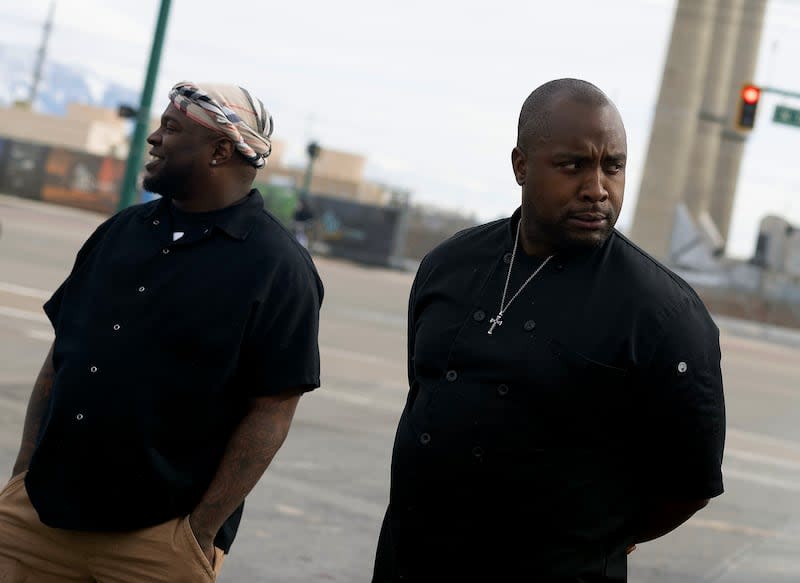
The same day Culture Coffee served its first cup, Benjamin Stalling fired up his smokers for the grand opening at Benji’s Bar-B-Que on North Temple. It shares a small, nondescript space with City Creek Pizza, a staple on the street for 25 years.
Stalling, a Georgia native whose family moved to Rose Park when he was a sophomore in high school, has opened several restaurants but none in the area where he grew up. He said he chose the location not because of the possibility of a ballpark across the street but because of the street itself.
“I would love this to be a landmark one day,” the West High School graduate said. “My goal is to be here on North Temple and represent my city.”
In the month he spent getting ready to open, Stalling, a BYU- and Harvard-educated owner of a financial services and consulting firm, saw firsthand the challenges west-side business owners face.
“Oh, my goodness. The crime is horrible,” he said.
Stalling watched unsuspecting drug buyers park next to a car wash and walk to the river trail to do the deal only to find their cars towed. “The tow truck drivers aren’t afraid of nothing. They’re all strapped,” he said. He saw police emerge from seemingly nowhere to descend on drug dealers in sting operations.
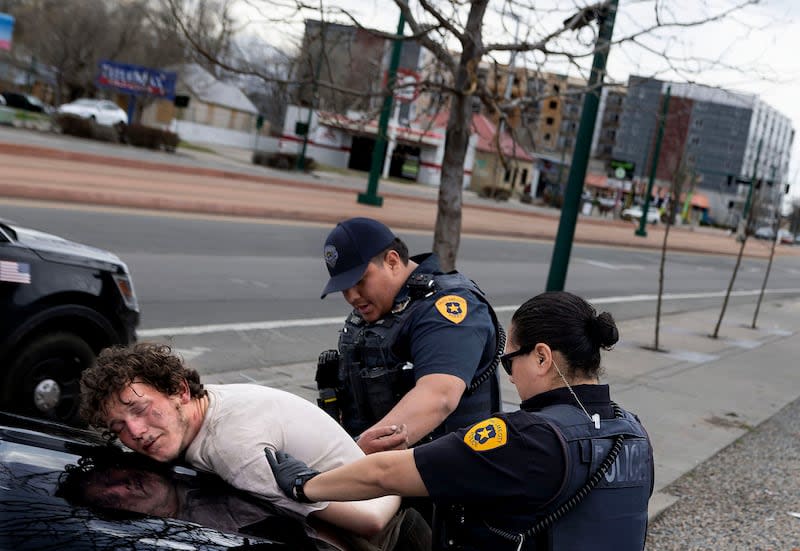
A walk in the park
On a partly sunny day that turned to rain near the end of March, photographer Laura Seitz and I walked the Jordan River Parkway Trail south from the Day-Riverside public library at 1000 North. Stretches of the brown river were choked with debris, mostly plastic soda bottles and drink cups, along with the occasional shopping cart or tire stuck in the mud. Trash, again plastic soda bottles and drink cups along with food wrappers and dirty clothes, were strewn along the river bank.
About a quarter mile in, we saw two men dragging a tent next to the trail. Aaron Hall and Dave Daniels told us the police had just kicked them out of their riverside camping spot and ordered them to leave their shopping carts behind. As they gathered up their few possessions, Hall complained about how homeless people who don’t clean up after themselves make it tough on everyone else. After going back and forth about what to do and where to go, the pair loaded up their carts anyway and pushed them down the trail.
A little further along the path, several people huddled under a bridge. A young man skipping rocks in the placid river told us he lives in Murray but likes to hang out on the west side. “The best thing about the west side,” he said, “is the view of the east side.”
In another quarter mile, we happened upon two pickup trucks pulling large trailers. A Bobcat operator with the city’s Rapid Intervention Team scooped up a tent, all of its contents along with a grocery cart and a hardware store panel truck, in its powerful jaws and deposited it all into a trailer. In a few minutes, the campsite was bare. Police officers rousted a couple of men behind a pine tree in an adjacent community garden. It was unclear whether the camp belonged to them. One of the workers told me that we wouldn’t be able to tell the crew was there four hours later.
A bridge over the river on North Temple at the west end of the Utah State Fairpark is the epicenter of the drug trade in the area. It is also the very spot on the river the LHM Company plans to bring change, incorporating it into a riverwalk as part of its development.
Several dozen people in ragged clothes congregated on the bank, just a few feet from an unoccupied Salt Lake City police/fire mobile command center just inside the fairgrounds fence. On the other side of the road, people ducked under the bridge to buy, sell and do drugs.
One man sat on the riverbank in what looked like a drug-induced stupor. Another on the pedestrian bridge held a lighter and a piece of tin foil with black residue. A woman carried what looked like a used condom to a trash can. Another woman filled her two-liter soda bottle in the murky river.
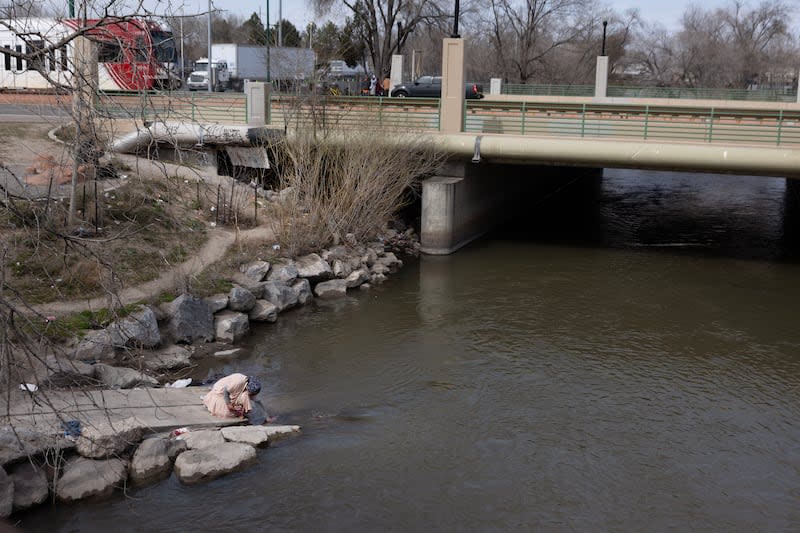
“Watch, she’ll drink it,” said a man who identified himself as a Volunteers of America volunteer who tries to help people in the area.
Two police officers stood guard at a lone green tent surrounded by police tape near the bridge. The woman who owns the tent told me that she and her friend let a man sleep in the tent with them the night before. They thought he was asleep when they left in the morning only to find him dead when they returned in the afternoon. A Salt Lake police report described the man as a drug addict known to use methamphetamine. Officers found him lying under a maroon blanket with an open beer can and store receipt for beer next to him.
Down the street, police arrested a man in the parking lot of a shuttered dry cleaner in a building that looks like a barn (home of The Red Barn restaurant in the ‘70s) and will soon be torn down to make way for an apartment building. There was a warrant for his arrest for allegedly smashing a Trax train window with his head on North Temple, according to a police report.
Neighborhood vibes
Marguerite Mower has lived in Rose Park for 30 years. She doesn’t feel safe walking the Jordan River Trail anymore. But she loves the neighborhood. She’s surrounded by good neighbors. Crime isn’t a worry on her street. Banks, a post office, a library and grocery stores are within a two-mile radius.
Like most west-side neighborhoods, Rose Park can carry a stigma: undesirable, high crime, people walking around with guns.
“I have had people grimace when I tell them I live in Rose Park,” Mower said. “I think people are afraid of diversity, people not looking like them. In the media, it’s portrayed as having a lot of crime.”
The west side, however, has caught the eye of developers. Several multistory apartment buildings have gone up in the past couple of years and more are under construction. The city created an Opportunity Zone, which offers some tax breaks to encourage long-term investments in low-income and urban communities along the North Temple corridor, which has made it one of the city’s most rapidly developing areas.
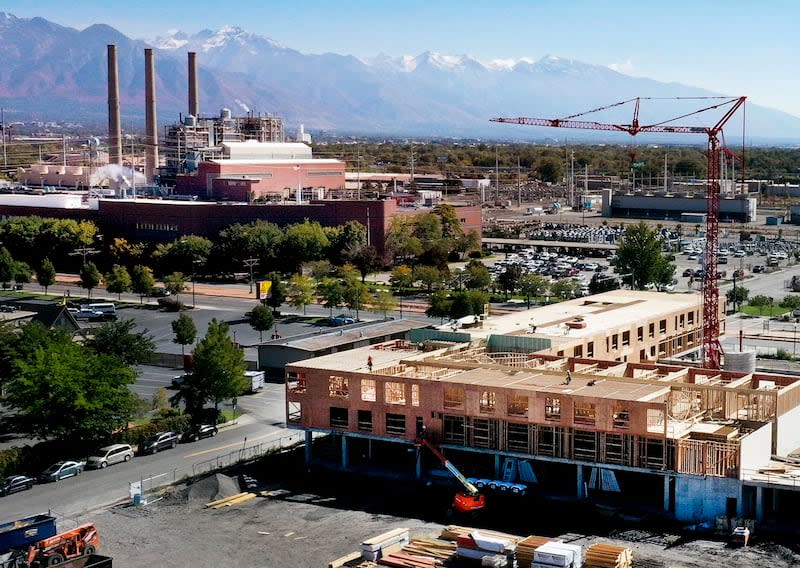
Garciaz, of NeighborWorks Salt Lake, said the construction is good because it creates more places for people to live, but it also brings challenges.
“I think that it would be nice if there were more thoughtful planning going into play instead of us just sort of building out all this housing,” she said. “It’s much-needed housing but I’m not sure that it’s well-planned out in terms of parking and the impact it’s going to have on communities.”
Also, the many one- and two-bedroom units don’t cater to families. Garciaz said the focus should be on retaining home ownership and building housing to accommodate families that will grow in the area.
Like everywhere else, housing costs in the Fairpark and Rose Park neighborhoods have shot up. A median-priced home goes for $420,000, up 47% from five years ago.
My hometown
Carlton Christensen lives in the Rose Park house he grew up in, going on 59 years now. He and his wife, Cathy, raised their two daughters there.
“We’ve enjoyed the diversity of the community. We’ve felt needed. We’ve felt like we could contribute in a meaningful way,” he said. “We also felt like we didn’t have to compete with our neighbors.”
The Christensens have contributed quite a bit over the years.
Carlton Christensen served on the Salt Lake City Council for 16 years. He’s currently Utah Transit Authority board chair. He just finished 10 years as a stake president for The Church of Jesus Christ of Latter-day Saints. And before he could catch his breath, the church called him and Cathy as executive directors of Operation My Hometown SLC Northwest, a nonproselytizing neighborhood improvement initiative in various areas along the Wasatch Front.
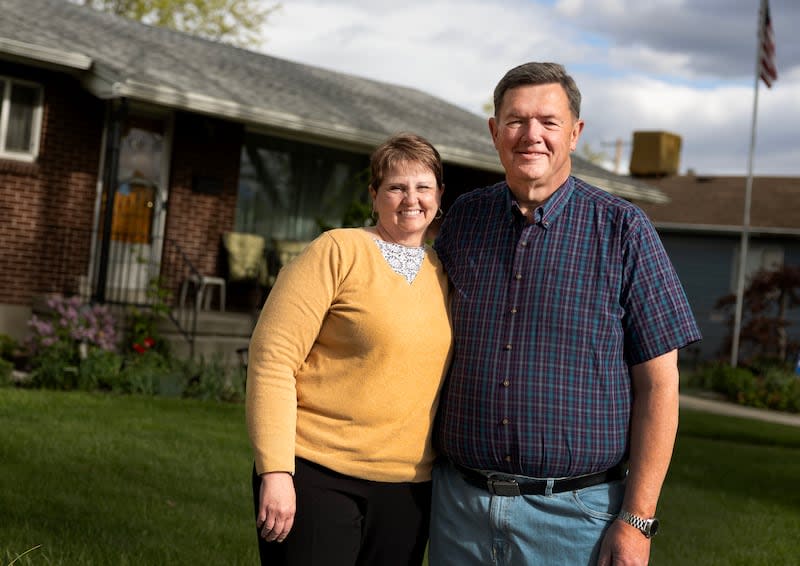
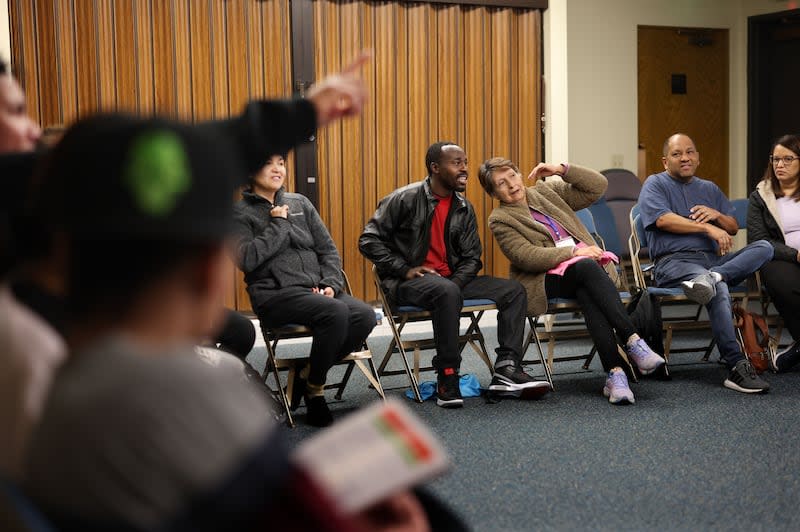
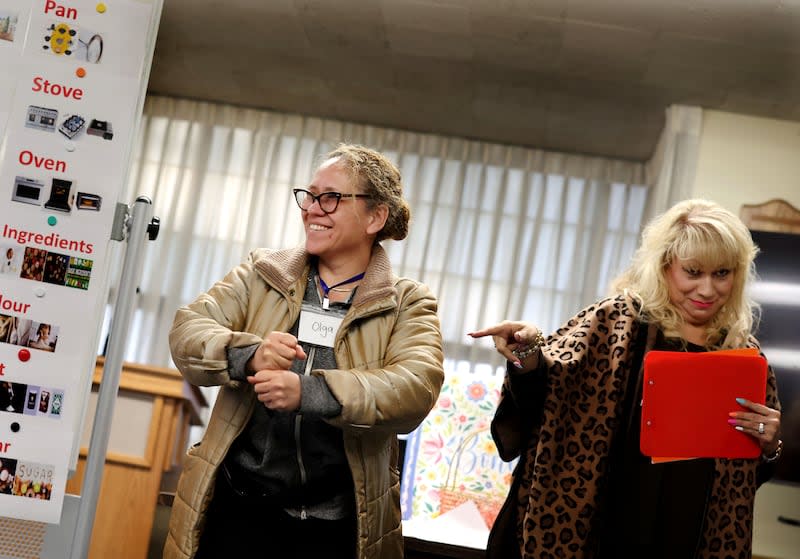
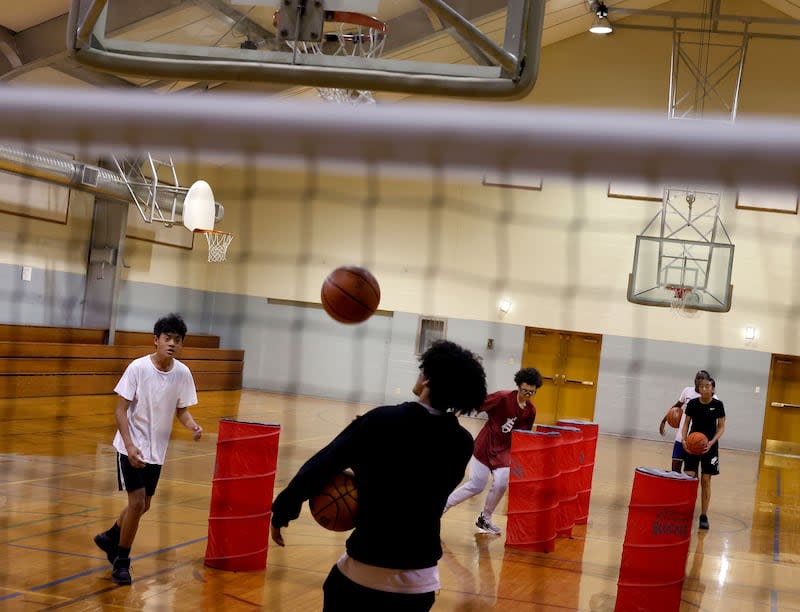
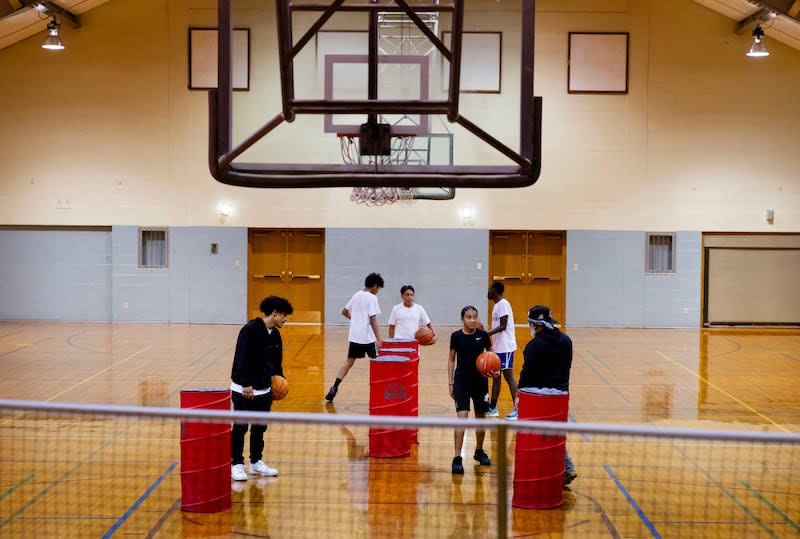
“It’s an evolving thing,” he said, adding they’re learning what needs the community has and how to respond to them. Christensen said it’s about creating strong friendships and connecting people with resources and helping them become more self-reliant.
About 40 service missionaries along with dozens of volunteers participate in various ways, including helping organize a PTA and strengthening the reading program in local schools. There’s a community resource center for people to play basketball or volleyball, learn English or take a computer course. They spruced up the grounds at a Buddhist temple, prompting a Baptist church to approach them for help. They made a home more accessible for a person with disabilities. They put on a youth dance.
Missionaries are helping a homeowner who had a fire in her home line up grants and other resources to rebuild the inside. On a Saturday in April, more than 500 people turned out to clean up a stretch of the Jordan River.
“In many ways, it is the Christ-like love we have been taught to share with others,” Christensen said.
Opening Day
Opening Day for Rose Park Baseball on a clear but windy day in April probably wasn’t much different than it was when the youth league started in 1955. The Lions Club sponsored a community breakfast, boys and girls in new uniforms ran around and played catch, parents smiled and greeted each other. The field at Riverside Park is the very one where the fictional Benny “The Jet” Rodriguez and his ragtag teammates in T-shirts and sneakers soundly beat the well-heeled team in fancy uniforms and cleats from the other side of town in “The Sandlot.”
“It’s our pride and joy, the beating heart of our community,” said Krista Cook, whose husband, Chris, coaches and whose two boys play in the league.
Retired major leaguers Dale Murphy and Jared Fernandez threw out the first pitch, along with some local political leaders and executives from the Larry H. Miller Company. The Larry H. & Gail Miller Family Foundation worked with Salt Lake City to fund and install new lights on the two baseball fields at the park and company employees painted the dugouts last year.
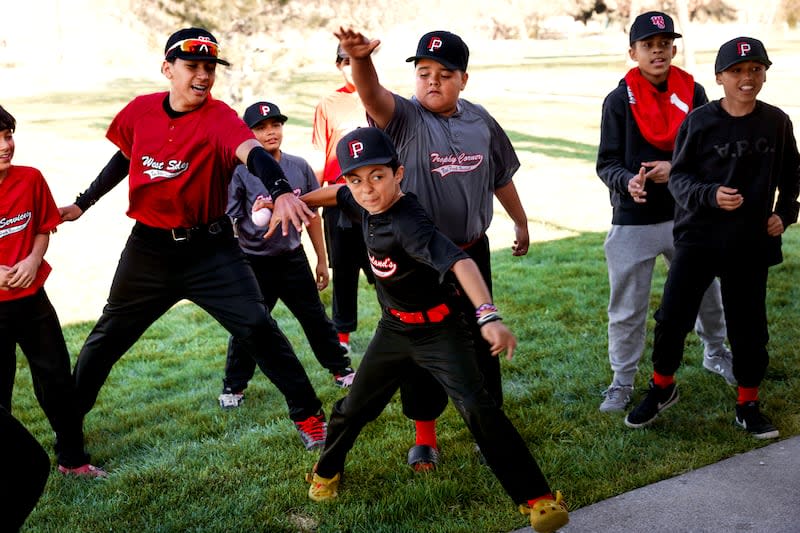
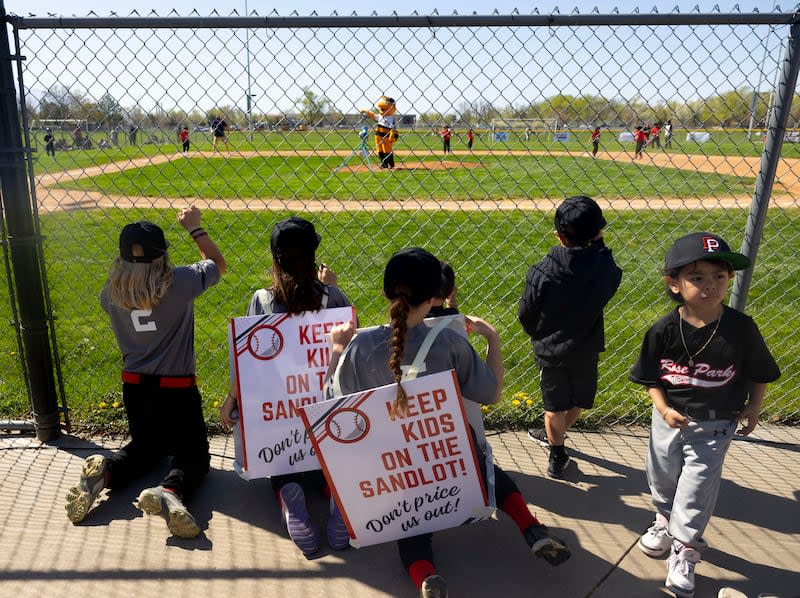
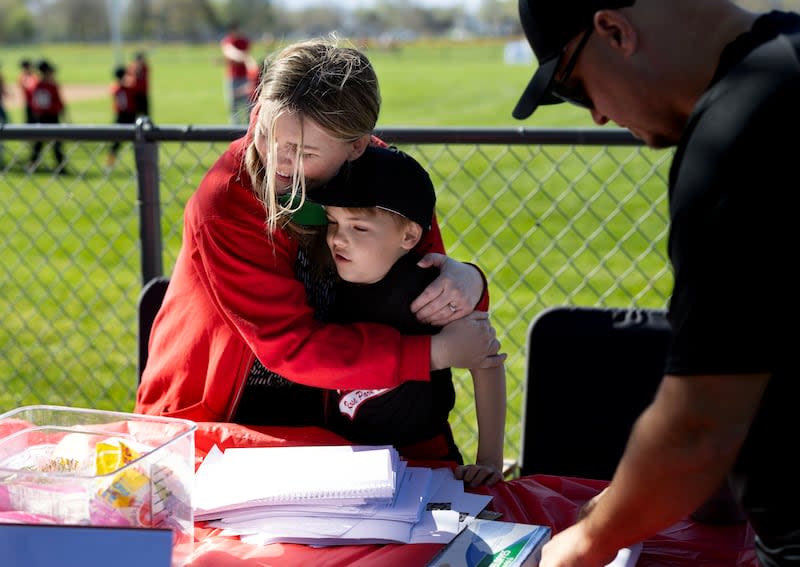
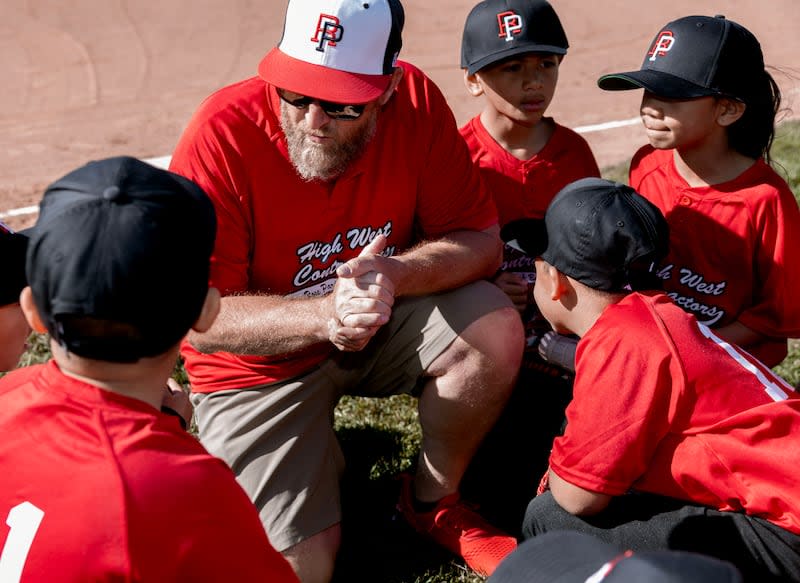
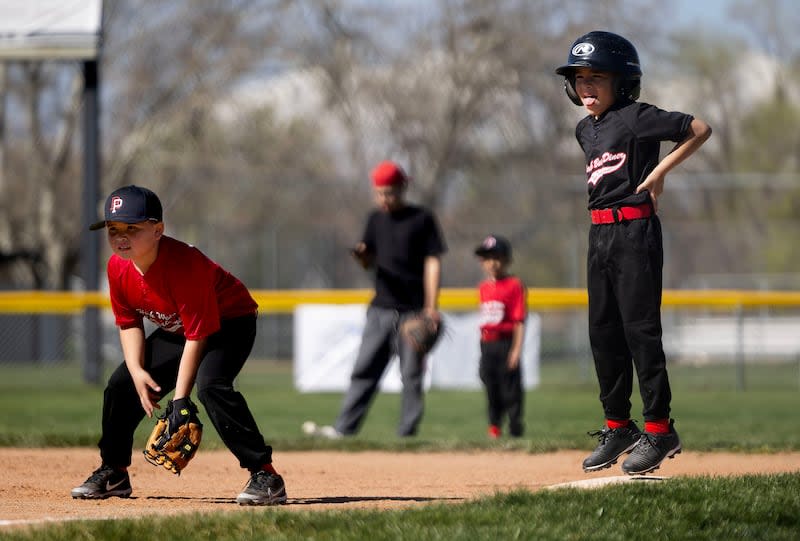
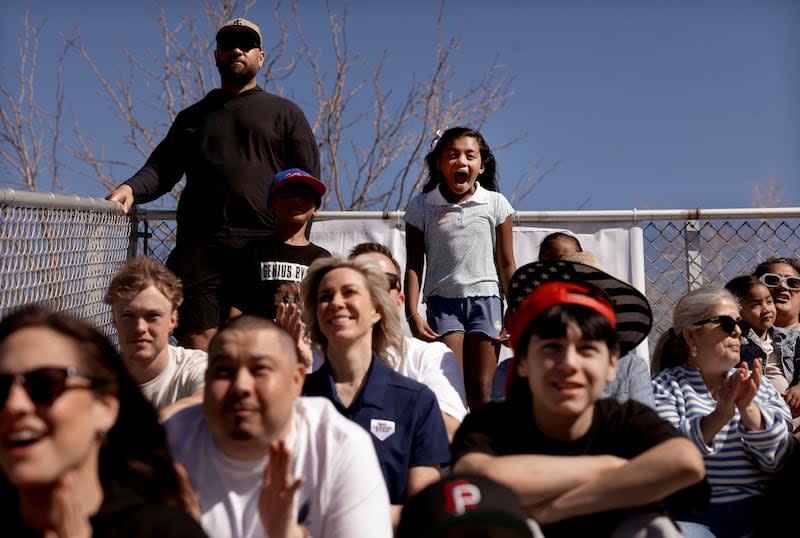
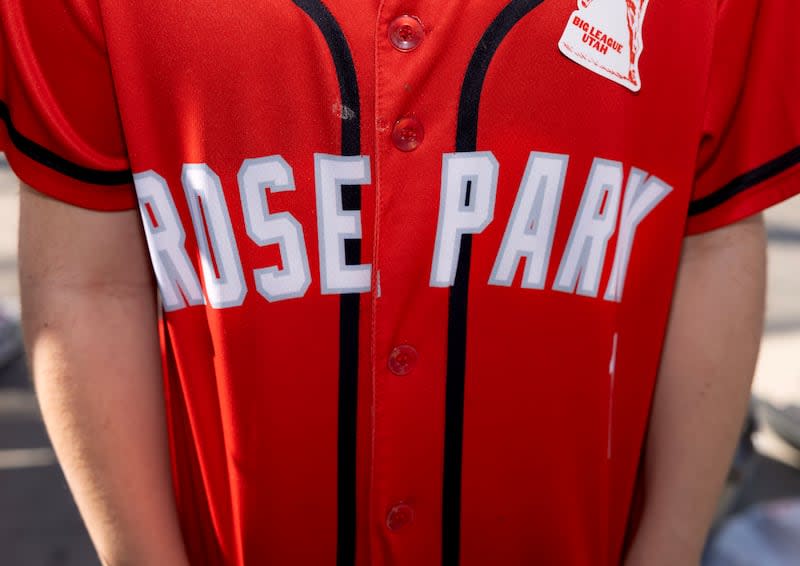
Despite the blue sky, a gray cloud hung over the festivities. Cook managed a table with a big sign reading, “Keep kids on the sandlot! Don’t price us out!” The city more than doubled its rental fee for the field, putting the league in a financial quandary. It’s trying to figure out how to pay the bills without making the cost to play prohibitive for families. Players, coaches and parents gathered around the table to scrawl letters urging the city to relent on the rate increase as Cook tried to corral the petitions in the wind.
League president James Walje said the cost jumped from about $8,000 to rent the fields to $20,000.
“That’s not sustainable. We can’t afford that year after year after year. We would die,” he said, adding the new lights would shine on an empty park.
Some relief might be in sight, though, as the City Council considers reducing the fee ahead of next year’s budget.
Cook can’t help but see the juxtaposition between the struggling league and the enormous amount of money going into a major league stadium just blocks away.
“As much as I care about the major league team, I care more about our little leaguers and our community. If you had to pick — and I want both — but this is where we should be investing the money. It’s our heart and soul,” Cook said.
Cook’s 10-year-old son, Wilson, wandered over in his still-clean Rose Park uniform. He said he’s excited for the possibility of major league baseball in his neighborhood but unsolicitedly offered, “That would be awesome but I don’t think many people in Rose Park could afford that.”
The average ticket price for a major league game goes up a little each year, hitting $37 in 2023, according to Statista. The average “cheap” ticket price, per MoneyGeek, is $17.67. Either way, it’s pricey to take a family to a game, which likely includes parking, drinks, snacks and souvenirs.
The big project
In February, the Larry H. Miller Company announced plans to invest in the west side on an unprecedented scale. LHM Company co-founder Gail Miller grew up just west of the state Capitol. She and her late husband, Larry, graduated from West High School. Larry Miller played softball on a field across the street from the fairgrounds that is now a vacant lot.
Plans for the company’s multibillion-dollar mixed-use development on 100 acres in what’s known as the Power District include “innovative” residential housing options, local dining and retail, “abundant” green space and trails, as well as a beautified Jordan River walk, and a potential major league ballpark, the piece that has everybody talking about it. LHM, supported by a group of prominent Utah business, civic and government leaders known as Big League Utah, is leading the effort to bring an MLB team to Salt Lake City.
But the project comes with a cost to taxpayers. The Utah Legislature authorized the newly created Utah Fairpark Area Investment and Restoration District to levy a host of taxes including an energy sales and use tax, a telecommunications license tax, a transient room tax and a resort communities sales and use tax. It also allows the district to boost the state’s rental car tax to raise hundreds of millions of dollars for the baseball stadium should LHM land a franchise. Strong, the Westside Coalition chair, will serve on the board that governs the district.
Many west-side residents cautiously welcome the Miller project and the prospect of Major League Baseball in their neighborhood, though there are some naysayers. They want to preserve the culture of the community and ensure people aren’t displaced.
“I think most people are really excited about that. I know that there’s alway some hesitancy for any big construction project. There’s fear about what we might lose,” Strong said, adding, “The devil’s going to be in the details.”
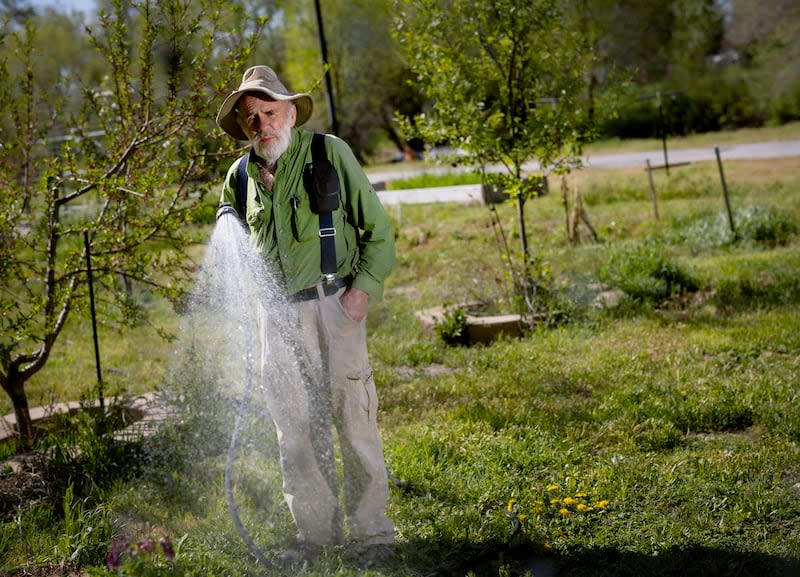
Tom King, 67, volunteers at a community garden along the Jordan River near his home. He’s not thrilled with all the new development, mainly the “high-density, high-priced” housing going up leading to more gentrification. He also doesn’t think highly of the state and city “wanting to have my tax money” to subsidize an already-wealthy corporation in LHM.
“That really kind of gets my goat,” he said.
The Bortzes love baseball. But they worry the community will become more gentrified with skyrocketing rent and home prices and that traffic will increase.
“There’ll be a lot of people that don’t know any of the history or culture of the neighborhood that are just going to come and be like ‘I’m here for the baseball’ and don’t have any idea about the roots that have been planted here,” Christian Bortz said.
Stalling, the North Temple barbecue joint owner, welcomes the gentrification. “I think it’s great,” he said.
“Once this project is underway, I’m telling you, it’s going to change this area like nobody’s business,” he said. “I think the cost of living is definitely going to go up. But with that it’s also going to bring a different group of people who are going to be able to come … make it a stronger, more positive area than what it was years ago or the last few decades.”
Atencio, the coffee and barber shop owner, said it’s about time the west side sees some real investment, though he wants to make sure it’s equitable and that locals “get the best shake of the whole deal.”
“I’m excited to see the neighborhood change and I’m excited to see something that big come and really boost the confidence of the people around here rather than make them feel kind of oppressed by it. The west side as a whole has been Salt Lake’s best kept secret forever. Everyone that lives here knows the truest sense of community, whether it’s little league baseball, whether it’s the Lions Club or the rec center, stuff is happening all the time.
“It’s something we’ve kept close to our chest for a long time and it’s time to share it.”
